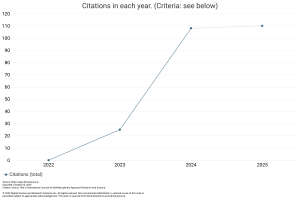Impact of Flood on Bayelsa State, Nigeria: Causes, Consequence, and Management Strategies
DOI:
https://doi.org/10.59653/ijmars.v3i03.1971Keywords:
Flooding, Bayelsa State, Niger Delta, Environmental Management, Disaster Risk ReductionAbstract
One of the most common and destructive environmental hazards in Nigeria has been flooding that has resulted in massive destruction of infrastructure, agriculture and human settlements. The geomorphological characteristics and the closeness of the Atlantic Ocean makes Bayelsa State, which is in the low-lying Niger Delta region, highly susceptible to floods. This paper will discuss the 2022 flood disaster that occurred in Bayelsa State, its physical and socioeconomic effects, the primary causes of the disaster, and some of the current measures taken with regards to flood management. The study is an empirical research based on the structured questionnaires, interviews and field observations conducted in seven communities across Bayelsa and Delta States, but also supported by secondary information, which presents multidimensional impacts of the flood. The findings noted that the flood swept away farmlands, animals, and households, displaced thousands of people, disrupted both transport and education and increased poverty and food insecurity. Results also suggest that ineffective drainage, level ground and lack of government preparedness are some of the factors that contributed to the disaster. The paper ends by giving recommendations on the need to actively manage river basins, to develop proper urban planning and to establish a good collaboration between the institutions to ensure the development of resilience against the occurrence of future floods.
Downloads
References
Abubakar, B., Umar, H., Barde, M. M., & Adamu, S. (2020). Socio-economic impact of flooding on the riverine communities of River Benue in Adamawa State, Nigeria. FUTY Journal of the Environment, 14(2). https://doi.org/10.4314/fje.v14i2.11
Aderogba, K. A. (2012). Qualitative studies of recent floods and sustainable growth and development of cities and towns in Nigeria. International Journal of Academic Research in Economics and Management Sciences, 1(3), 1-25.
Apan, A., Keogh, D., King, D., Thomas, M., Mushtaq, S., & Baddiley, P. (2010). The 2008 floods in Queensland: A case study of vulnerability, resilience and adaptive capacity (Report No 16/10). National Climate Change Adaptation Research Facility.
Barrow, C. J. (1998). River basin development planning and management: A critical review. World Development, 26(1), 171-186. https://doi.org/10.1016/S0305-750X(97)10017-1
Biswas, A. K. (2004). Integrated water resources management: A reassessment. Water International, 29(2), 248-256. https://doi.org/10.1080/02508060408691775
Blaikie, P., Cannon, T., Davis, I., & Wisner, B. (1994). At Risk: Natural Hazards, People’s Vulnerability and Disasters. Routledge.
Bradshaw, C. J. A., Sodhi, N. S., Peh, K. S. H., & Brook, B. W. (2007). Global evidence that deforestation amplifies flood risk in the developing world. Global Change Biology 13(11), 2379–2395. https://doi.org/10.1111/j.1365-2486.2007.01446.x
Douglas, I., Alam, K., Maghenda, M., McDonnell, Y., McLean, L., & Campbell, J. (2008). Unjust waters: Climate change, flooding and the urban poor in Africa. Environment and Urbanization, 20(1), 187–205. https://doi.org/10.1177/0956247808089156
Ezenweani, R. S. (2017). A comprehensive collation of river basins in Nigeria: Benefits and river basin development planning and management. International Journal of Scientific & Engineering Research, 8(11), 1587-1595.
Federal Ministry of Humanitarian Affairs. (2022). 2022 Flood Situation Report. Abuja: Government of Nigeria.
Komolafe, A. A., Adegboyega, S. A., & Akinluyi, F. O. (2015). A review of flood risk analysis in Nigeria. Journal of Geography and Regional Planning, 8(8), 193-204
Liu, J., Zhang, Q., Singh, V. P., Song, C., Zhang, Y., Sun, P., & Gu, X. (2018). Hydrological effects of climate variability and vegetation dynamics on annual fluvial water balance in global large river basins. Hydrology and Earth System Sciences, 22, 4047-4060
Nkwunonwo, U. C. (2016). A review of flooding and flood risk reduction in Nigeria. Global Journal of Human-Social Science: B (Geography, Geo-Sciences, Environmental Science & Disaster Management), 16(B2), 23-42.
Nkwunonwo, U. C., Whitworth, M., & Baily, B. (2016). Review article: A review and critical analysis of the efforts towards urban flood risk management in the Lagos region of Nigeria. Natural Hazards and Earth System Sciences, 16, 349-369.
Peduzzi, P., Dao, H., Herold, C., & Mouton, F. (2009). Assessing global exposure and vulnerability towards natural hazards: The Disaster Risk Index. Natural Hazards and Earth System Sciences, 9(4), 1149–1159. https://doi.org/10.5194/nhess-9-1149-2009
Petroski, H. (2006). Levees and other raised ground. American Scientist, 94(1), 7-11.
Punch Newspaper. (2022, October 15). Over 300 Bayelsa communities submerged by flood. Punch Nigeria.
Qomariyatus, S., Wahyudi, K. C., & Sri, W. (2020). The analysis of the causes of flood disasters and their impacts in the perspective of environmental law. IOP Conference Series: Earth and Environmental Science, 437(1), 012056.
Smith, K., & Ward, R. (1998). Floods: Physical processes and human impacts. John Wiley & Sons.
Teclaff, L. A. (1996). Evolution of the river basin concept in national and international water law. Natural Resources Journal, 36(2), 359-391.
Umar, N., & Gray, A. (2022). Flooding in Nigeria: a review of its occurrence and impacts and approaches to modelling flood data. International Journal of Environmental Studies, 80(3), 540-561. https://doi.org/10.1080/00207233.2022.2081471
United Nations Office for Disaster Risk Reduction [UNISDR] (2009). 2009 UNISDR terminology on disaster risk reduction. UNDRR.
Watson, A., Vystavna, Y., Kralisch, S., et al. (2022). Towards the development of an isotope-enabled rainfall-runoff model: improving the ability to capture hydrological and anthropogenic change. Hydrological Processes, 37(2), Article e14819.
Downloads
Published
How to Cite
Issue
Section
Categories
License
Copyright (c) 2025 Jude Okeibunor Nwambuonwo, Ogheneovo Maureen Atie, Mariam Reuben-Okoye

This work is licensed under a Creative Commons Attribution-ShareAlike 4.0 International License.
Authors who publish with this journal agree to the following terms:
- Authors retain copyright and grant the journal right of first publication with the work simultaneously licensed under a Creative Commons Attribution-ShareAlike that allows others to share the work with an acknowledgement of the work's authorship and initial publication in this journal.
- Authors are able to enter into separate, additional contractual arrangements for the non-exclusive distribution of the journal's published version of the work (e.g., post it to an institutional repository or publish it in a book), with an acknowledgement of its initial publication in this journal.
- Authors are permitted and encouraged to post their work online (e.g., in institutional repositories or on their website) prior to and during the submission process, as it can lead to productive exchanges, as well as earlier and greater citation of published work (See The Effect of Open Access).
























